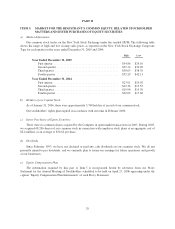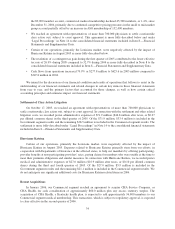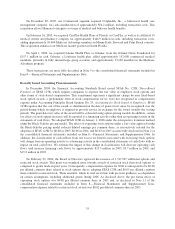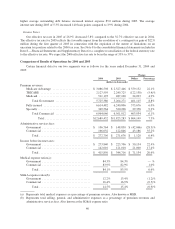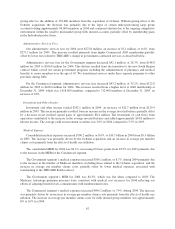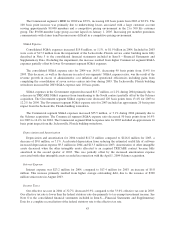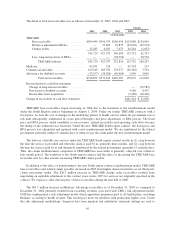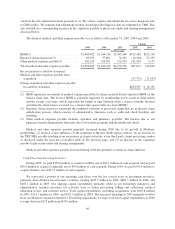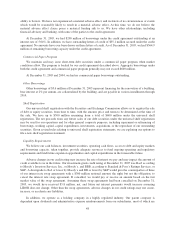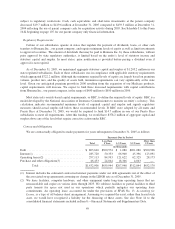Humana 2005 Annual Report Download - page 49
Download and view the complete annual report
Please find page 49 of the 2005 Humana annual report below. You can navigate through the pages in the report by either clicking on the pages listed below, or by using the keyword search tool below to find specific information within the annual report.The MER for the Commercial segment of 83.3% in 2005 decreased 60 basis points from the 2004 MER of
83.9%. Higher medical expenses from Hurricane Katrina increased the 2005 MER 30 basis points. After
considering the effect of Hurricane Katrina, the decrease in MER for the 2005 period primarily reflects the
absence of the unprofitable 89,000-member large group account that lapsed on January 1, 2005.
SG&A Expense
Consolidated selling, general, and administrative (SG&A) expenses increased $298.9 million or 15.9%
during 2005 primarily resulting from an increase in the number of employees due to the Medicare expansion, the
class action litigation settlement, and increased advertising and marketing costs also due to the Medicare
expansion. These increases were partially offset by a decrease in administrative expenses associated with
transitioning to the TRICARE South contract in 2004. During 2005, the number of employees increased 5,000 to
18,700 at December 31, 2005, primarily in the sales and customer service functions associated with the growth in
the Medicare business, as well as approximately 1,200 employees added with the CarePlus acquisition.
The SG&A expense ratio, which is computed by taking total selling, general, and administrative expenses as
a percentage of premium revenues and administrative services fees, represents a key industry statistic used to
measure administrative spending efficiency.
The consolidated SG&A expense ratio for 2005 was 15.3%, increasing 80 basis points from 14.5% for 2004.
Expenses related to the class action litigation settlement increased the SG&A expense ratio 50 basis points for
2005. After considering the effect of the class action litigation expenses, the SG&A expense ratio increase
primarily resulted from a commercial membership mix shift and increased spending associated with the Medicare
expansion. The consolidated SG&A expense ratio is expected to be in the range of 12% to 13% for 2006
reflecting the continuing beneficial effect of growth in revenues and membership leveraging fixed costs.
Our Government and Commercial segments bear direct and indirect overhead SG&A expenses. We allocate
indirect overhead expenses shared by the two segments primarily as a function of revenues. As a result, the
profitability of each segment is interdependent.
SG&A expenses in the Government segment increased $246.2 million, or 34.7% during 2005 due to the
CarePlus acquisition, increased spending associated with the Medicare expansion, and the class action litigation
settlement. These increases were partially offset by a decrease in TRICARE expenses from the transition to the
South contract in 2004. The Government segment SG&A expense ratio increased 40 basis points from 12.2% for
2004 to 12.6% for 2005. Expenses related to the class action litigation settlement increased the SG&A expense
ratio 40 basis points for 2005.
The Commercial segment SG&A expenses increased $52.7 million, or 4.5% during 2005. The Commercial
segment SG&A expense ratio increased 190 basis points from 16.4% for 2004 to 18.3% for 2005. Expenses
related to the class action litigation settlement increased the SG&A expense ratio 60 basis points for 2005. After
considering the effect of the class action litigation expenses, this increase resulted from the continued shift in the
mix of membership towards ASO. ASO business bears a significantly higher SG&A ratio than fully insured
business.
Depreciation and Amortization
Depreciation and amortization for 2005 totaled $128.9 million compared to $117.8 million for 2004, an
increase of $11.1 million, or 9.4%. Amortization of other intangible assets increased $13.3 million during 2005
primarily as a result of intangible assets recorded in connection with the CarePlus acquisition.
Interest Expense
Interest expense was $39.3 million for 2005, compared to $23.2 million for 2004, an increase of $16.1
million. This increase primarily resulted from higher interest rates and higher average outstanding debt. The
39


